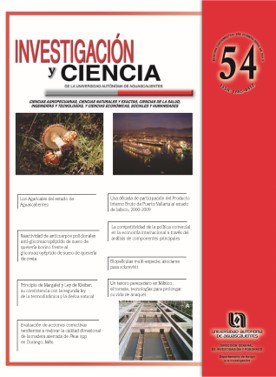Biopelículas multi-especie: asociarse para sobrevivir
DOI:
https://doi.org/10.33064/iycuaa2012544086Palabras clave:
biopelículas multi-especie, ciclo celular, matriz extracelular, resistencia antimicrobiana, quorum sensing, FISHResumen
Las biopelículas son una estrategia de supervivencia para los microorganismos que les permite la colonización de ambientes hostiles, tejidos del hospedero o superficies inertes, aún en condiciones cambiantes y para las bacterias patógenas representan un mecanismo de dispersión de infecciones. Debido a lo anterior, el estudio de las biopelículas permite comprender nuevas formas
de colonización, resistencia a antibióticos, transferencia horizontal de genes, entre otros mecanismos compartidos por los microorganismos que las conforman. Así, el propósito de la presente revisión es brindar un conocimiento general de estas comunidades, resaltando su importancia en el ambiente y las interacciones entre las especies que participan en su formación.
Descargas
Citas
• ALMEIDA, C.; AZEVEDO, N.F.; SANTOS, S.; KEEVIL, C.; VIEIRA, M., Discriminating Multi-Species Populations in Biofilms with Peptide Nucleic Acid Fluorescence In Situ Hybridization (PNA FISH). PLoS ONE, 6(3): 147-186, 2011.
• BORDI, C.; DE BENTZMANN, S., Hacking into bacterial biofilms: a new therapeutic challenge. Annals of Intensive Care, 1(19), 2011.
• BOWEN, W.H.; KOO, H., Biology of Streptococcus mutans-derived glucosyltransferases: Role in Extracellular Matrix Formation of Cariogenic Biofilms. Caries Research, 45: 69-86, 2011.
• BRENCI, A.; McFARLAND, K.A.; McMANUS, H.R.; CASTANG, S.; MOGNO, I.; CHEN, L.; Wen, Y., The role of bacterial biofilms in persistent infections and control strategies. International Journal of Oral Science, 3: 66-73, 2011.56
• CIOFU, O.; RIIS, B.; PRESSLER, T.; POULSEN, H.E.; HØIBY, N., Occurrence of hypermutable Pseudomonas aeruginosa in cystic fibrosis patients is associated with the oxidative stress caused by chronic lung inflammation. Antimicrobial Agents and Chemotherapy, 49: 2276-2282, 2005.
• DEHIO, C.; MEYER, M.; BERGER, J.; SCHWARZ, H.; LANZ., C., Interaction of Bartonella henselae with endothelial cells results in bacterial aggregation on the cell surface and the subsequent engulfment and internalization of the bacterial aggregate by a unique structure, the invasome. Journal of Cell Science, 110: 2141-2154, 1997.
• GANGULY, S.; MITCHELL, A., Mucosal biofilms of Candida albicans. Current Opinion in Microbiology, 14: 1-6, 2011.
• HALL-STOODLEY, L.; STOODLEY, P., Envolving concepts in biofilm infections. Cellular Microbiology, 11(7): 1034-1043, 2009.
• HANSEN, S.K.; RAINEY, P.B.; HAAGENSEN, J.A.; MOLIN, S., Evolution of species interactions in a biofilm community. Nature, 445: 533-536, 2007.
• HARRIOTT, M.M.; NOVERR, M.C., Ability of Candida albicans mutants to induce Staphylococcus aureus vancomycin resistance during polymicrobial biofilm formation. Antimicrobial Agents and Chemotherapy, 54: 3746-3755, 2010.
• HØIBY, N.; CIOFU, O.; JOHANSEN, H.K.; SONG, Z.; MOSER, C.; JENSEN, P.Ø.; MOLIN, S.; GIVSKOV, M.; TOLKER NIELSEN, T.; BJARNSHOLT, T., The clinical impact of the bacterial biofilms. International Journal of Oral Science, 3(2):55-65, 2011.
• LABRIE, J.; PELLETIER-JACQUES, G.; DESLANDES, V.; RAMJEET, M.; AUGER, E.; NASH, J.H.E.; JACQUES, M., Effects of growth conditions on biofilm formation by Actinobacillus pleuropneumoniae. Veterinary Research, 41(3),2010.
• LOERA, V.; GARCIDUEÑAS, C.; AVELAR, F.; RAMÍREZ, E.; GUERRERO, A., Biopelículas: estrategias de resistencia y ataque para la patogénesis bacteriana. Scientiae Nature, 10(2): 5-16, 2008.
• MAZZOLI, S., Biofilms in chronic bacterial prostatitis (NIHII) and in prostatic calcifications. Federation of European Materials Societies, Immunology & Medical Microbiology, 59: 337-344, 2010.
• MERRITT, J.H.; KADOURI, D.E.; O’Toole, G.A., Growing and analyzing static biofilms. Current Protocols in Microbiology, 1B.1.1-1B.1.17, 2005.
• NAZAR, J., Biofilms bacterianos. Revista Otorrinolaringología, 67(1): 61-72, 2007.
• PEREIRA, A.L.; SILVA, T.N.; GOMES, A.C.; ARAÚJO, A.C.; GIAUGLIANNO, L.G., Diarrhea-associated biofilm formed by enteroaggregative Escherichia coli and aggregative Citrobacter freundii: a consortium mediated by putative F pili. BioMedical Center Microbiology, 10(57),2010.
• RAYNER, M.G.; ZHANG, Y.; GORRy, M.C.; CHEN, y.; POST, J.C.; EHRILH, G.D., Evidences of bacterial metabolic activities in culture-negative otitis media with effusion. Journal of the American Medical Association, 279: 296-299, 1998.
• RENDUELES, O.; TRAVIER, L.; LATOUR-LAMBERT, P.; FONTAINE, T.; MARGNUS, J.; DENAMUR, E.; CHINGO, J.M., Screening of Escherichia coli Species Biodiversity Reveals New Biofilm-Associated Antiadhesion Polysaccharides. Malaysian Bio-industry Organisation, 2(3): e00043-11, 2011.
• RICKARD, A.H.; GILBERT, P.; HIGH, N.J.; KOLENBRANDER, P.E.; HANDLEY, P.S., Bacterial coaggregation: an integral process in the development of multi-species biofilms. Trends in Microbiology, 11(2), 2003.
• SIMÕES, L.C.; SIMÕES, M.; VIEIRA, M.J., Biofilm Interactions between distinct bacterial genera isolated from drinking water. Applied and Environmental Microbiology, 73(19): 6192-6200, 2007.
• STERNBERG, C; TOLKER-NIELSEN, T., Growing and analyzing biofilms in flow cells. Current Protocols in Microbiology, Chapter 1, Unit 1B 2, 2006.
• TRAPPETTI, C.; OGUNNIYI, A.; OGGIONI, M.; PATON, J., Extracellular Matrix Formation Enhances the Ability of Streptococcus pneumoniae to Cause Invasive Disease. PLoS ONE, 6(5): e19844, 2011.
• WAGNER, C.; KONDELLA, K.; BERNSCHNEIDER, T.; HEPPERT, V.; WENTZENSEN, A.; HÄNSH, G.M., Post-traumatic osteomyelitis: analysis of inflammatory cells recruited into the site of infection. Shock, 20: 503-510, 2003.
• WILES, T.J.; KULESUS, R.R.; MULVEY, M.A., Origins and Virulence Mechanisms of Uropathogenic Escherichia coli. Experimental and Molecular Pathology, 85(1): 11-19, 2008.
• YAMAMOTO, D.; HERNÁNDEZ, R.T.; BLANCO, M.; GREUNE, L.; SCHIMIDT, M.A.; CARNEIRO, S.M.; DAHBI, G.; BLANCO, J.E.; GOMES, T.A.T., Invasiveness as a putative additional virulence mechanism of some atypical Enteropathogenic Escherichia coli strains with different uncommon intimin types. BioMed Central Microbiology. 9 235, 2009.
• Yang, L.; Liu, Y.; Wu, H.; Høiby, N.; Molin, S.; Song, Z., Current understanding of multi-species biofilms. International Journal of Oral Science, 74-81, 2011.
Descargas
Publicado
Cómo citar
Licencia
Derechos de autor 2012 Abraham Loera Muro, Flor Yazmín Ramírez Castillo, Francisco Javier Avelar González, Alma Lilián Guerrero Barrera

Esta obra está bajo una licencia internacional Creative Commons Atribución-NoComercial-CompartirIgual 4.0.
Las obras publicadas en versión electrónica de la revista están bajo la licencia Creative Commons Atribución-NoComercial-CompartirIgual 4.0 Internacional (CC BY-NC-SA 4.0)









